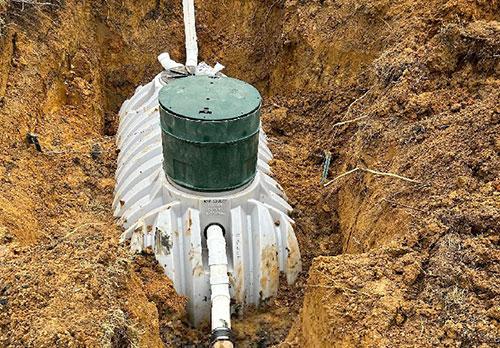
Serving : Ontario, Seneca, Wayne and Cayuga Counties
Septic Installation Near Ontario County, New York
MCGHAN INCORPORATED is Committed to superior quality and results!

AVOID COSTLY MISTAKES:
Do NOT hire an excavating contractor without first reading our free guide:
The ULTIMATE Excavation & Septic "Success Guide."

Septic Installation Near Ontario County, New York: What You Need to Know
When your property isn't connected to a municipal sewer system, a septic system is the best way to manage wastewater. If you're looking for septic installation near Ontario County, New York, you need to know what the process involves, the benefits of hiring a professional, and how to make the best decision for your home or business.
How Can We Help?


The Benefits of Septic Installation Near Ontario County, New York
Investing in a septic system offers several advantages for homeowners and businesses in Ontario County. Here’s why it’s a smart choice:
1. Independence from Municipal Sewer Systems
A properly installed septic system means you’re not reliant on city sewer lines. This is especially important in rural areas where sewer access may not be available.
2. Cost Savings Over Time
Although the upfront installation cost may seem high, a well-maintained septic system can last for decades with minimal maintenance costs compared to ongoing municipal sewer fees.
3. Environmentally Friendly Waste Management
Septic systems naturally treat wastewater through soil filtration, reducing pollution. With proper care, they help protect local water sources in Ontario County, New York.
4. Custom Solutions for Any Property
Whether you need a system for a single-family home, a commercial property, or a rural farm, a septic installation can be tailored to meet your specific needs.
5. Increased Property Value
A properly installed and maintained septic system is an asset. It makes a property more appealing to buyers who want to avoid the costs of connecting to a municipal sewer.
The Process for Hiring a Septic Installation Near Ontario County, New York
When planning a septic installation, following the right steps ensures a smooth process. Here’s what to expect:
1. Site Evaluation and Soil Testing
Before installation, a soil percolation test determines if the ground can absorb and filter wastewater efficiently. Ontario County has specific regulations requiring these tests before approving a septic system.
2. System Design and Permits
Septic systems must be designed to fit the property’s size, usage, and soil conditions. Local authorities in Ontario County, New York, require specific permits before any work begins.
3. Choosing the Right Septic System
There are different types of septic systems, including:
○ Conventional Septic Systems – Standard systems with a septic tank and drain field.
○ Aerobic Treatment Units (ATUs) – Systems that use oxygen to break down waste more efficiently.
○ Mound Systems – Raised drain fields for properties with poor soil conditions.
4. Excavation and Tank Placement
Once the system is approved, excavation begins. The septic tank is placed underground, and the drain field is constructed to allow wastewater to be filtered naturally.
5. Installation of Pipes and Drain Field
Pipes are installed to transport waste from the home to the tank, and then from the tank to the drain field. Proper sloping ensures gravity helps move wastewater efficiently.
6. System Inspection and Testing
Before use, the system undergoes inspection to confirm it meets Ontario County, New York health and environmental standards.
7. Backfilling and Final Setup
Once approved, the system is covered, and the final grading ensures proper drainage. Grass or gravel is often placed over the drain field to prevent soil erosion.
See Our Excavation & Septic Services

✔️ Commercial Excavation
✔️ Residential Excavation
✔️ Basement Excavation
✔️ Demolition
✔️ Large Pond Construction
✔️ Small Pond Construction
✔️ Dozer Work
✔️ Septic Installs Traditional Systems
✔️ Septic Tanks - Aerobic Systems
✔️ Septic Tanks - Concrete
✔️ Drain Field Replacement
Quality Services Launched FAST!

✔️ Forestry Mulching
✔️ Grading
✔️ Lot Clearing
✔️ French Drains
✔️ Sewer Repairs
✔️ Camera Inspections
✔️ Drainage Systems
✔️ Full Site Preparation
✔️ Trenching
✔️ Utilities Trenching
What Are You Waiting For?
How to Choose the Right Septic Installation Near Ontario County, New York
1. Verify Licensing and Certification
Ensure the installer has the necessary certifications and permits required in Ontario County, New York for septic system installation.
2. Ask for References and Reviews
A good septic installer will have positive reviews from past clients. Check online feedback and ask for references to verify their work quality.
3. Get a Detailed Estimate
Request an itemized estimate covering labor, materials, permits, and potential extra costs.
4. Ensure Proper Warranty and Maintenance Plans
A quality installer should offer a warranty on their work and provide maintenance recommendations to keep the system running efficiently.
5. Understand Local Regulations
Ontario County has specific guidelines for septic installations, including setback distances from wells and water sources. Work with a contractor who understands these requirements.
Maintaining Your Septic System for Long-Term Efficiency
Once your septic system is installed, proper maintenance is crucial for its longevity. Follow these best practices:
○ Pump the Tank Regularly – Schedule routine pumping based on household size and water usage.
○ Be Mindful of What You Flush – Avoid flushing wipes, grease, chemicals, and non-biodegradable items.
○ Reduce Water Waste – Excessive water usage can overload the system. Install water-saving fixtures to minimize strain.
○ Protect the Drain Field – Keep heavy vehicles and structures off the drain field to prevent damage.
○ Schedule Routine Inspections – Regular professional inspections catch potential issues early and save costly repairs.
Hours: Mon-Sun 7.30am-5pm
Extended hours by appointment only.
Address: 4265 Route 96A, Geneva, NY 14456, United States
All rights reserved | Client Support Area